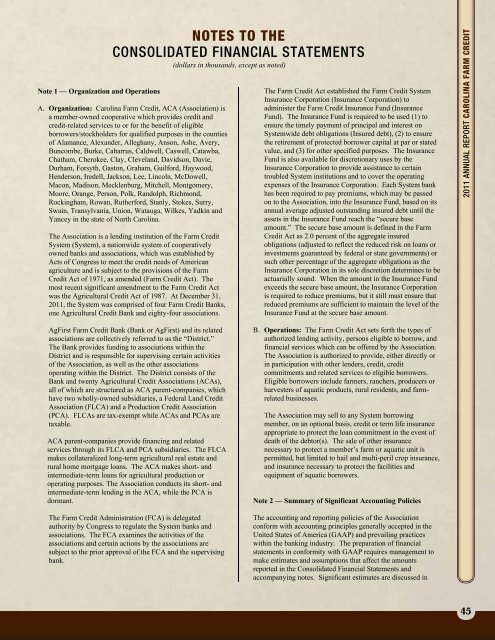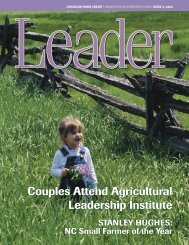2011 Annual Report - Carolina Farm Credit
2011 Annual Report - Carolina Farm Credit
2011 Annual Report - Carolina Farm Credit
You also want an ePaper? Increase the reach of your titles
YUMPU automatically turns print PDFs into web optimized ePapers that Google loves.
<strong>Carolina</strong> <strong>Farm</strong> <strong>Credit</strong>, ACA<br />
Notes to consolidated the Consolidated financial Financial statements Statements<br />
Note 1 — Organization and Operations<br />
A. Organization: <strong>Carolina</strong> <strong>Farm</strong> <strong>Credit</strong>, ACA (Association) is<br />
a member-owned cooperative which provides credit and<br />
credit-related services to or for the benefit of eligible<br />
borrowers/stockholders for qualified purposes in the counties<br />
of Alamance, Alexander, Alleghany, Anson, Ashe, Avery,<br />
Buncombe, Burke, Cabarrus, Caldwell, Caswell, Catawba,<br />
Chatham, Cherokee, Clay, Cleveland, Davidson, Davie,<br />
Durham, Forsyth, Gaston, Graham, Guilford, Haywood,<br />
Henderson, Iredell, Jackson, Lee, Lincoln, McDowell,<br />
Macon, Madison, Mecklenburg, Mitchell, Montgomery,<br />
Moore, Orange, Person, Polk, Randolph, Richmond,<br />
Rockingham, Rowan, Rutherford, Stanly, Stokes, Surry,<br />
Swain, Transylvania, Union, Watauga, Wilkes, Yadkin and<br />
Yancey in the state of North <strong>Carolina</strong>.<br />
The Association is a lending institution of the <strong>Farm</strong> <strong>Credit</strong><br />
System (System), a nationwide system of cooperatively<br />
owned banks and associations, which was established by<br />
Acts of Congress to meet the credit needs of American<br />
agriculture and is subject to the provisions of the <strong>Farm</strong><br />
<strong>Credit</strong> Act of 1971, as amended (<strong>Farm</strong> <strong>Credit</strong> Act). The<br />
most recent significant amendment to the <strong>Farm</strong> <strong>Credit</strong> Act<br />
was the Agricultural <strong>Credit</strong> Act of 1987. At December 31,<br />
<strong>2011</strong>, the System was comprised of four <strong>Farm</strong> <strong>Credit</strong> Banks,<br />
one Agricultural <strong>Credit</strong> Bank and eighty-four associations.<br />
notes to the<br />
(dollars in thousands, except as noted)<br />
(dollars in thousands, except as noted)<br />
The <strong>Farm</strong> <strong>Credit</strong> Act established the <strong>Farm</strong> <strong>Credit</strong> System<br />
Insurance Corporation (Insurance Corporation) to<br />
administer the <strong>Farm</strong> <strong>Credit</strong> Insurance Fund (Insurance<br />
Fund). The Insurance Fund is required to be used (1) to<br />
ensure the timely payment of principal and interest on<br />
Systemwide debt obligations (Insured debt), (2) to ensure<br />
the retirement of protected borrower capital at par or stated<br />
value, and (3) for other specified purposes. The Insurance<br />
Fund is also available for discretionary uses by the<br />
Insurance Corporation to provide assistance to certain<br />
troubled System institutions and to cover the operating<br />
expenses of the Insurance Corporation. Each System bank<br />
has been required to pay premiums, which may be passed<br />
on to the Association, into the Insurance Fund, based on its<br />
annual average adjusted outstanding insured debt until the<br />
assets in the Insurance Fund reach the “secure base<br />
amount.” The secure base amount is defined in the <strong>Farm</strong><br />
<strong>Credit</strong> Act as 2.0 percent of the aggregate insured<br />
obligations (adjusted to reflect the reduced risk on loans or<br />
investments guaranteed by federal or state governments) or<br />
such other percentage of the aggregate obligations as the<br />
Insurance Corporation in its sole discretion determines to be<br />
actuarially sound. When the amount in the Insurance Fund<br />
exceeds the secure base amount, the Insurance Corporation<br />
is required to reduce premiums, but it still must ensure that<br />
reduced premiums are sufficient to maintain the level of the<br />
Insurance Fund at the secure base amount.<br />
<strong>2011</strong> <strong>Annual</strong> <strong>Report</strong> <strong>Carolina</strong> <strong>Farm</strong> <strong>Credit</strong><br />
AgFirst <strong>Farm</strong> <strong>Credit</strong> Bank (Bank or AgFirst) and its related<br />
associations are collectively referred to as the “District.”<br />
The Bank provides funding to associations within the<br />
District and is responsible for supervising certain activities<br />
of the Association, as well as the other associations<br />
operating within the District. The District consists of the<br />
Bank and twenty Agricultural <strong>Credit</strong> Associations (ACAs),<br />
all of which are structured as ACA parent-companies, which<br />
have two wholly-owned subsidiaries, a Federal Land <strong>Credit</strong><br />
Association (FLCA) and a Production <strong>Credit</strong> Association<br />
(PCA). FLCAs are tax-exempt while ACAs and PCAs are<br />
taxable.<br />
ACA parent-companies provide financing and related<br />
services through its FLCA and PCA subsidiaries. The FLCA<br />
makes collateralized long-term agricultural real estate and<br />
rural home mortgage loans. The ACA makes short- and<br />
intermediate-term loans for agricultural production or<br />
operating purposes. The Association conducts its short- and<br />
intermediate-term lending in the ACA, while the PCA is<br />
dormant.<br />
The <strong>Farm</strong> <strong>Credit</strong> Administration (FCA) is delegated<br />
authority by Congress to regulate the System banks and<br />
associations. The FCA examines the activities of the<br />
associations and certain actions by the associations are<br />
subject to the prior approval of the FCA and the supervising<br />
bank.<br />
B. Operations: The <strong>Farm</strong> <strong>Credit</strong> Act sets forth the types of<br />
authorized lending activity, persons eligible to borrow, and<br />
financial services which can be offered by the Association.<br />
The Association is authorized to provide, either directly or<br />
in participation with other lenders, credit, credit<br />
commitments and related services to eligible borrowers.<br />
Eligible borrowers include farmers, ranchers, producers or<br />
harvesters of aquatic products, rural residents, and farmrelated<br />
businesses.<br />
The Association may sell to any System borrowing<br />
member, on an optional basis, credit or term life insurance<br />
appropriate to protect the loan commitment in the event of<br />
death of the debtor(s). The sale of other insurance<br />
necessary to protect a member’s farm or aquatic unit is<br />
permitted, but limited to hail and multi-peril crop insurance,<br />
and insurance necessary to protect the facilities and<br />
equipment of aquatic borrowers.<br />
Note 2 — Summary of Significant Accounting Policies<br />
The accounting and reporting policies of the Association<br />
conform with accounting principles generally accepted in the<br />
United States of America (GAAP) and prevailing practices<br />
within the banking industry. The preparation of financial<br />
statements in conformity with GAAP requires management to<br />
make estimates and assumptions that affect the amounts<br />
reported in the Consolidated Financial Statements and<br />
accompanying notes. Significant estimates are discussed in<br />
27<br />
<strong>2011</strong> <strong>Annual</strong> <strong>Report</strong><br />
45





